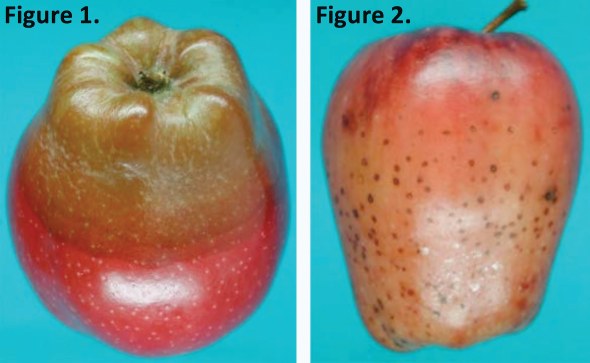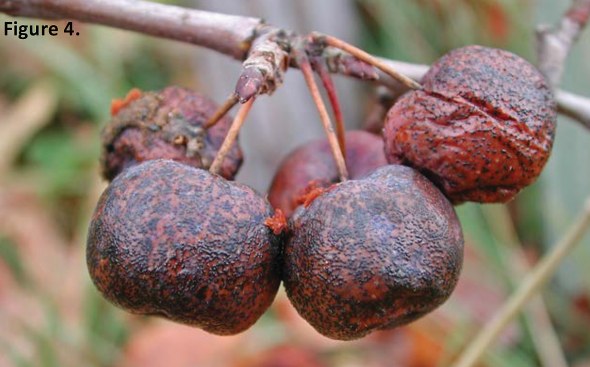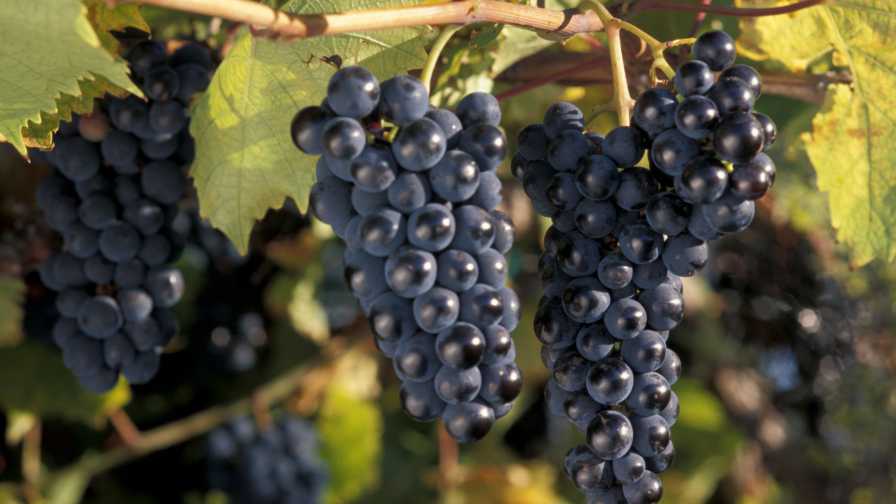Research Is Vital To Keep Asian Apple Export Markets Open

Desmond Layne
With the large domestic production of U.S. apples in recent years, Asian export markets (China, etc.) are vital. This is particularly the case for Washington Red Delicious — a popular, iconic apple in China. The USDA recently announced China has opened its market to all U.S. apples.
A vital aspect to maintaining market access is ensuring that the fruit going into China is free of quarantine pests and pathogens that the Chinese government is concerned about. In fact, it was because of interception of apples with particular pathogens (e.g., speck rot, bull’s eye rot, and Sphaeropsis rot, see Figures 1 and 2) by Chinese officials that market access was closed to U.S. apples between 2012 and 2014.

Sphaeropsis rot Speck rot (Fig. 1) and speck rot (Fig. 2) is seen on Red Delicious apple. Both rots can occur either on the stem or calyx end of the fruit showing stem-end rot symptoms. (Photos used with permission from C.L. Xiao, USDA-ARS, Parlier, CA)
A multidisciplinary team of scientists in Washington is currently working on a “Technical Assistance for Specialty Crops (TASC)” project through the USDA’s Foreign Agricultural Service in a systems approach to address management of the aforementioned diseases to maintain market access.
The proposal was authored by Mike Willett of the Northwest Horticultural Council and is being managed by the Washington Apple Commission. Key scientists include Mark Mazzola of the USDA’s Agricultural Research Service and Parama Sikdar, Stefano Musacchi, and Karen Lewis of Washington State University. There is also participation from the Washington Tree Fruit Research Commission, Northwest Fruit Explorers, and Richard Kim of Pace International.
The Trouble With The Manchurian Crabapple
The Manchurian crabapple is a popular and widely inter-planted pollinizer in most commercial apple orchards in Washington. Unfortunately, while Manchurian blooms at the right time, it has a couple of significant problems.
First, it is a host for speck rot and Sphaeropsis rot organisms. Second, the mature trees can be very thorny and prunings cast to the orchard floor can puncture tractor tires, so pruned wood must be hauled out of the orchard for this reason.

Manchurian crabapple trees show signs of twig dieback (white arrows), canker (between blue arrows) and black fruiting bodies (between yellow arrows). (Photo used with permission from C.L. Xiao, USDA-ARS, Parlier, CA)
Because of the latter issue, it was typically not regularly pruned, and pathogen inoculum could build up over time on the Manchurian crabapple trees and serve as a source for infection of adjacent apple trees. Rain, overhead irrigation and overhead cooling for sunburn control can all spread fungal spores from infected twigs and fruits of the crabapple trees to nearby apples (Figures, 3, 4, and 5).
Although latent infections may result on the apples while they are still on the tree, rot symptoms do not develop until later — either during cold storage or at the commercial market. Rot symptoms can occur at either the calyx or stem end of the fruit.
Research Into Alternatives
The TASC team is conducting research on disease management (e.g., removing infected crabapple wood plus postharvest fungicide applications to apples), identifying an alternative pollinizer to Manchurian, improved packinghouse inspection and detection, and grower education.
Preliminary results from multiple orchard trial sites indicated that the combined practice of both pruning Manchurian crabapple plus treatment with an effective postharvest fungicide substantially reduced postharvest rot of apples in storage when compared with fruit collected from trees adjacent to crabapples that were not pruned and where the apples were not treated with the postharvest fungicide.

Fungal fruiting bodies are seen on Manchurian crab apple fruit. (Photo used with permission from C.L. Xiao, USDA-ARS, Parlier, CA)
Diverse crabapple germplasm is currently being evaluated for consideration as a Manchurian replacement.
Disease resistance, annual blooming, correct bloom timing, attractiveness of flowers to bees, pollen viability, and compatibility with current apple varieties to ensure efficient fertilization and fruit set are all critical to finding a suitable replacement.
In a future column, I hope to share TASC team results about the quest for a replacement pollinizer. Please stay tuned.

Fungal fruiting bodies on mummified Manchurian crabapple fruit. These present a tremendous source of pathogen inoculum. (Photo used with permission from P. Sikdar, Washington State University, Wenatchee, WA)
Online Resources
Three helpful Extension outreach factsheets with additional information have been prepared so growers can read to learn more. These are:
- Guidelines for control of speck rot in apples
- Guidelines for control of Sphaeropsis rot in apples
- Guidelines on pruning Manchurian crabapple for fruit rot control
- In addition, we have created a new educational video on YouTube: “Managing quarantine-significant postharvest diseases in Pacific Northwest apple and pear orchards” and discusses the disease cycle and control of speck and Sphaeropsis rot. It includes an in-field demonstration by Tom Auvil of the Washington Tree Fruit Research Commission on how to make suitable pruning cuts and what limbs to remove from infected Manchurian crabapples to reduce inoculum in the field.










